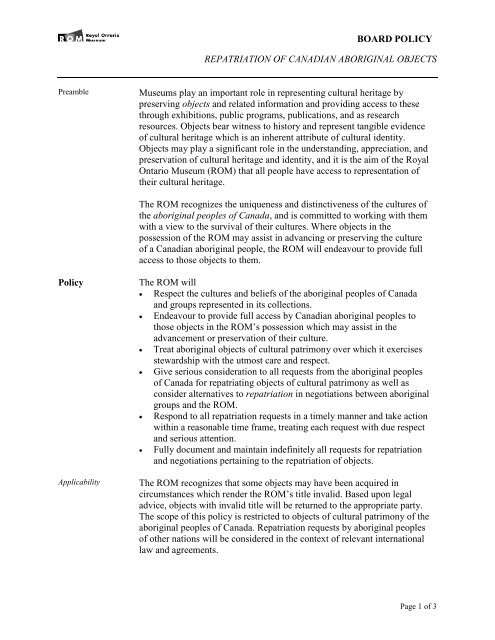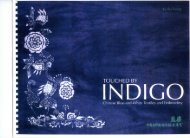Repatriation of Canadian Aboriginal Objects - Royal Ontario Museum
Repatriation of Canadian Aboriginal Objects - Royal Ontario Museum
Repatriation of Canadian Aboriginal Objects - Royal Ontario Museum
You also want an ePaper? Increase the reach of your titles
YUMPU automatically turns print PDFs into web optimized ePapers that Google loves.
BOARD POLICY<br />
REPATRIATION OF CANADIAN ABORIGINAL OBJECTS<br />
Preamble<br />
<strong>Museum</strong>s play an important role in representing cultural heritage by<br />
preserving objects and related information and providing access to these<br />
through exhibitions, public programs, publications, and as research<br />
resources. <strong>Objects</strong> bear witness to history and represent tangible evidence<br />
<strong>of</strong> cultural heritage which is an inherent attribute <strong>of</strong> cultural identity.<br />
<strong>Objects</strong> may play a significant role in the understanding, appreciation, and<br />
preservation <strong>of</strong> cultural heritage and identity, and it is the aim <strong>of</strong> the <strong>Royal</strong><br />
<strong>Ontario</strong> <strong>Museum</strong> (ROM) that all people have access to representation <strong>of</strong><br />
their cultural heritage.<br />
The ROM recognizes the uniqueness and distinctiveness <strong>of</strong> the cultures <strong>of</strong><br />
the aboriginal peoples <strong>of</strong> Canada, and is committed to working with them<br />
with a view to the survival <strong>of</strong> their cultures. Where objects in the<br />
possession <strong>of</strong> the ROM may assist in advancing or preserving the culture<br />
<strong>of</strong> a <strong>Canadian</strong> aboriginal people, the ROM will endeavour to provide full<br />
access to those objects to them.<br />
Policy<br />
Applicability<br />
The ROM will<br />
• Respect the cultures and beliefs <strong>of</strong> the aboriginal peoples <strong>of</strong> Canada<br />
and groups represented in its collections.<br />
• Endeavour to provide full access by <strong>Canadian</strong> aboriginal peoples to<br />
those objects in the ROM’s possession which may assist in the<br />
advancement or preservation <strong>of</strong> their culture.<br />
• Treat aboriginal objects <strong>of</strong> cultural patrimony over which it exercises<br />
stewardship with the utmost care and respect.<br />
• Give serious consideration to all requests from the aboriginal peoples<br />
<strong>of</strong> Canada for repatriating objects <strong>of</strong> cultural patrimony as well as<br />
consider alternatives to repatriation in negotiations between aboriginal<br />
groups and the ROM.<br />
• Respond to all repatriation requests in a timely manner and take action<br />
within a reasonable time frame, treating each request with due respect<br />
and serious attention.<br />
• Fully document and maintain indefinitely all requests for repatriation<br />
and negotiations pertaining to the repatriation <strong>of</strong> objects.<br />
The ROM recognizes that some objects may have been acquired in<br />
circumstances which render the ROM’s title invalid. Based upon legal<br />
advice, objects with invalid title will be returned to the appropriate party.<br />
The scope <strong>of</strong> this policy is restricted to objects <strong>of</strong> cultural patrimony <strong>of</strong> the<br />
aboriginal peoples <strong>of</strong> Canada. <strong>Repatriation</strong> requests by aboriginal peoples<br />
<strong>of</strong> other nations will be considered in the context <strong>of</strong> relevant international<br />
law and agreements.<br />
Page 1 <strong>of</strong> 3
BOARD POLICY<br />
REPATRIATION OF CANADIAN ABORIGINAL OBJECTS<br />
Criteria<br />
Approval Levels<br />
Every repatriation case is unique and requires special consideration. The<br />
ROM will:<br />
• Decide on a case-by-case basis whether to return objects <strong>of</strong> cultural<br />
patrimony pursuant to a written request.<br />
• Only consider repatriation request for objects <strong>of</strong> cultural patrimony,<br />
including but not limited to burial objects and sacred objects.<br />
• Exercise due diligence in notifying other groups or individuals who it<br />
reasonably believes may have an interest in requests that are made for<br />
repatriation.<br />
• Return burial objects from the graves <strong>of</strong> individuals or groups <strong>of</strong><br />
individuals either to the identified descendents <strong>of</strong> the interred or to an<br />
affiliated aboriginal group.<br />
The repatriation <strong>of</strong> objects in the ROM’s collection requires the approval<br />
<strong>of</strong> the Board <strong>of</strong> Trustees. Any alternatives to repatriation will also require<br />
the approval <strong>of</strong> the Board.<br />
The status <strong>of</strong> all repatriation requests that have not been the subject <strong>of</strong> final<br />
disposition by the Board will be reported to the Board at least quarter<br />
yearly.<br />
A copy <strong>of</strong> all inquiries regarding <strong>Repatriation</strong> <strong>of</strong> <strong>Canadian</strong> <strong>Aboriginal</strong><br />
<strong>Objects</strong> will be sent to the <strong>of</strong>fice <strong>of</strong> the Deputy Director, Collections and<br />
Research (DDC&R). The DDC&R will notify the CER Committee <strong>of</strong> all<br />
requests for repatriation <strong>of</strong> said objects and provide progress reports to the<br />
Committee on those requests.<br />
Explanation <strong>of</strong><br />
Terms<br />
affiliated aboriginal group: a relationship <strong>of</strong> shared group identity which<br />
can be reasonably traced between a present day person or group and an<br />
identifiable earlier group. Grounds for establishing cultural affiliations<br />
shall be: a preponderance <strong>of</strong> evidence based on geographical kinship,<br />
biological, archaeological, anthropological, linguistic, folkloric, oral<br />
tradition, historical and other relevant information, or expert opinion.<br />
aboriginal peoples <strong>of</strong> Canada: includes the Indian, Inuit and Metis peoples<br />
<strong>of</strong> Canada.<br />
burial objects: objects that as part <strong>of</strong> death rite or ceremony <strong>of</strong> a culture,<br />
were placed or reasonably believed to have been placed with an<br />
individual’s human remains either at the time <strong>of</strong> burial or later.<br />
objects: artifacts held in the ROM’s collections.<br />
Page 2 <strong>of</strong> 3
BOARD POLICY<br />
REPATRIATION OF CANADIAN ABORIGINAL OBJECTS<br />
objects <strong>of</strong> cultural patrimony: objects which have significant historical,<br />
traditional or cultural importance central to the ongoing identity <strong>of</strong> the<br />
aboriginal group or culture in which the object originated. <strong>Objects</strong> <strong>of</strong><br />
cultural patrimony, with the exception <strong>of</strong> certain burial objects, should not<br />
be considered the property <strong>of</strong> an individual but the property <strong>of</strong> an<br />
aboriginal people.<br />
repatriation: the return <strong>of</strong> objects <strong>of</strong> aboriginal cultural patrimony held in<br />
the ROM’s collections to the aboriginal peoples <strong>of</strong> Canada. <strong>Objects</strong> <strong>of</strong><br />
aboriginal cultural patrimony include burial objects, sacred objects and<br />
other objects <strong>of</strong> significant and central historical, traditional or cultural<br />
importance to an aboriginal people.<br />
sacred objects: specific ceremonial objects which are needed for the<br />
practice <strong>of</strong> traditional religions by their present-day aboriginal adherents.<br />
Date Approved August 30, 2001<br />
Amended August 29, 2002. (Housekeeping changes only)<br />
September 6, 2007 (Housekeeping changes only)<br />
September 24, 2009 (New language)<br />
December 10, 2009 (Removal <strong>of</strong> language)<br />
November 15, 2012 (no changes)<br />
Next review 2015<br />
MONITORING<br />
Adherence to Policy<br />
Board:<br />
The Collections, Exhibitions and Research Committee will monitor<br />
management’s adherence to the policy.<br />
Management: The Director & CEO and the Deputy Director <strong>of</strong> Collections and Research will<br />
ensure that the Collections, Exhibitions and Research Committee has all the<br />
relevant information for determining adherence.<br />
Policy Review<br />
Method<br />
Internal Report<br />
Responsibility Collections, Exhibitions and Research Committee<br />
Frequency Every three years (next review 2012)<br />
Page 3 <strong>of</strong> 3
















